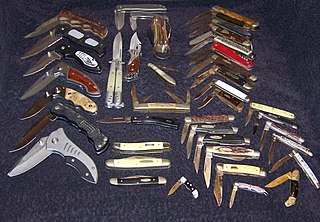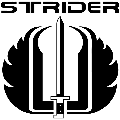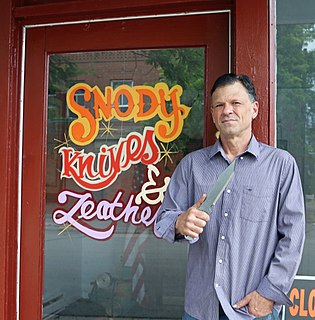
A knife is a tool with a cutting edge or blade attached to a handle or hilt. One of the earliest tools used by mankind, knives appeared at least two-and-a-half million years ago, as evidenced by the Oldowan tools. Originally made of wood, bone, and stone, over the centuries, in step with improvements in both metallurgy and manufacturing, knife blades have been made from copper, bronze, iron, steel, ceramic, and titanium. Most modern knives have either fixed or folding blades; blade patterns and styles vary by maker and country of origin.

A pocketknife is a foldable knife with one or more blades that fit inside the handle that can still fit in a pocket. It is also known as a jackknife (jack-knife) or a penknife, though a penknife may also be a specific kind of pocketknife. A typical blade length is 5 to 15 centimetres. Pocketknives are versatile tools, and may be used for anything from opening an envelope, to cutting twine, slicing a piece of fruit or even as a means of self-defense.

The Opinel company has manufactured and marketed a line of eponymous wooden-handled knives since 1890 from its headquarters in Saint-Jean-de-Maurienne, Savoie, France — where the family-run company also operates a museum dedicated to its knives. The company sells approximately 15 million knives annually. Opinel knives are made of both high carbon and stainless steel, the latter being the highest quality Sandvik steel from Sweden.

Strider Knives, Inc. is a custom and production knifemaking facility headed by Mick Strider based in San Marcos, California.
Spyderco is an American cutlery company based in Golden, Colorado, U.S.A., producing knives and knife sharpeners. Spyderco pioneered many features that are now common in folding knives, including the pocket clip, serrations, and the opening hole. Spyderco has collaborated with 30 custom knife makers, athletes, and self-defense instructors for designs and innovated the usage of 20 different blade materials.

Christopher Stanley "Chris" Reeve is a South African-American knife maker, recognized as one of the most influential people in knife making history. Reeve founded Chris Reeve Knives (CRK), and is co-owner of the company with his wife, Anne Reeve. In 2015 he was inducted into the Blade Magazine Hall of Fame.

The Strider MARSOC SMF is a framelock folding knife that was specifically developed for Detachment 1, the first SOCOM unit of the United States Marine Corps. The Strider SMF was the first knife issued to an individual Marine Corps unit in over 60 years and the first tactical folder issued within the USMC.

The Linerlock is a locking mechanism for folding pocket knives. A Linerlock is a folding knife with a side-spring lock that can be opened and closed with one hand without repositioning the knife in the hand. The lock is self-adjusting for wear. The modern Linerlock traces its lineage to the late 19th century, but in the 1980s the design was improved by American custom knifemaker Michael Walker.
Cold Steel, Inc. is an American manufacturer and retailer of knives/bladed tools, training weapons, swords and other martial arts edged and blunt weapons, based in Ventura, California. Cold Steel products are manufactured worldwide, including in the United States, Japan, mainland China, Taiwan, India, Italy and South Africa.

The Sebenza is a folding pocket knife manufactured by Chris Reeve Knives of Boise, Idaho. It is constructed with a stainless steel blade and titanium handle. Its handle functions as the lock mechanism similar in concept to the Walker linerlock differing in that the handle itself forms the lock bar which holds the blade open. This mechanism was invented by Chris Reeve, and is called the Reeve Integral Lock (R.I.L). It is also commonly referred to as the Framelock, and is one of the most widely implemented locking systems in the folding knife industry, where lock strength and reliability is a product requirement. The name Sebenza is derived from the Zulu word meaning "Work," a tribute to Mr. Reeve's South African origins.
CPM S30V is a martensitic (hardened) powder-made (sintered) wear and corrosion resistant stainless steel developed by Dick Barber of Crucible Industries in collaboration with knifemaker Chris Reeve. Its chemistry promotes the formation and even distribution of vanadium carbides, which are harder and more effective at cutting than chromium carbides. These vanadium carbides give the steel a very refined grain, further improving the sharpness and toughness. Despite some difficulties with a consistent heat-treat, knifemakers use CPM S30V because its composition makes it easier to grind than other powder steels although the carbides still wear down the grinder belts considerably. Its composition is as follows: Carbon 1.45%, Chromium 14.00%, Vanadium 4.00%, Molybdenum 2.00%. Barber received feedback from a number of other knife users and knifemakers such as Sal Glesser, Ernest Emerson, Tony Marfione, Phil Wilson, William Harsey Jr., Tom Mayo, Jerry Hossom, and Paul Bos in the development of CPM S30V.
Chris Reeve Knives is an American knife manufacturing corporation with international sales and distribution headquartered in Boise, Idaho, that designs, develops, and sells folding pocket knives and fixed-blade knives. Its products include the Sebenza, Inkosi, Umnumzaan, TiLock, Mnandi folding knives, Impinda slip joint, and the Green Beret, Pacific, Professional Soldier, Nyala, and Sikayo fixed blade knives. Chris Reeve Knives' industry contributions include the Integral Lock, contributions to the blade steel CPM S35VN, and has won Blade Magazine's Blade Show Manufacturing Quality Award 15 times. Their motto is Think Twice, Cut Once.

Columbia River Knife & Tool, Inc. (CRKT) is an American knife company established in 1994, and currently based in Tualatin, Oregon, United States. The company's president and sales executive is Rod Bremer and the finance executive is Peggy Bremer.

The CQC-6 or Viper Six is a handmade tactical folding knife with a tantō blade manufactured by knifemaker Ernest Emerson. Although initially reported as the sixth design in an evolution of fighting knives and the first model in the lineup of Emerson's Specwar Custom Knives, Emerson later revealed that the knife was named for SEAL Team Six. It has a chisel-ground blade of ATS-34 or 154CM stainless steel and a handle made of titanium and linen micarta. The CQC-6 is credited as the knife that popularized the concept of the tactical folding knife.

The SARK or NSAR is a folding knife designed by knifemaker Ernest Emerson for use as a search and rescue knife by the US military. It has a hawkbill with a blunt tip in order to cut free trapped victims without cutting them in the process. There is a variant with a pointed-tip designed for police, known as the P-SARK.
Emerson Knives, Inc. is an American company that produces knives and related products. It was founded in 1996 by custom knifemaker Ernest Emerson in an effort to mass-produce his folding knife designs for the U.S. Military and collector markets.

The Commander (knife) is a large recurve folding knife made by Emerson Knives, Inc. that was based on a custom design, the ES1-M, by Ernest Emerson that he originally built for a West Coast Navy SEAL Team. It was winner of the Blade Magazine Overall Knife of the Year Award for 1999.

Mike Snody is a Southern Texas knife maker who is known for his use of exotic materials in his custom knives. He is currently based in Walsenburg, Colorado.

Medford Knife and Tool is an American custom and production knifemaking and tactical tool making facility founded by Greg Medford in 2010 in Arizona United States.















